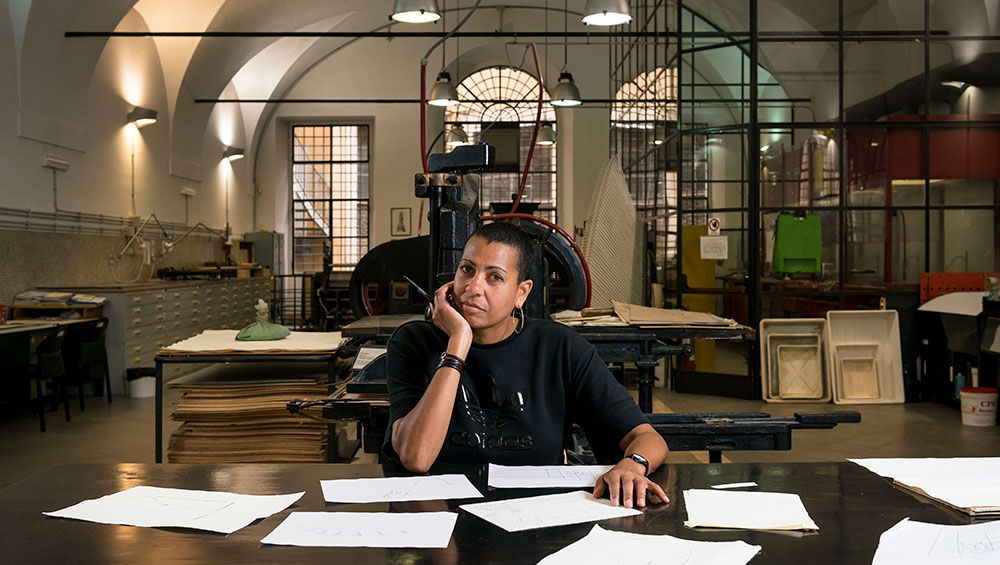
Helen Cammock.
by DAVID TRIGG
The relationship between word and image is fundamental to the videos, prints and performances of the British artist Helen Cammock. Characterised by discursive and fragmentary narratives, her work weaves autobiography with astute sociopolitical observation. Recent projects have explored the role of women in the struggle for civil rights during the Troubles in Northern Ireland (The Long Note, 2018) and the notion of lament, particularly women’s lament, in relation to loss, longing, resilience and resistance (Che Si Può Fare, 2019).
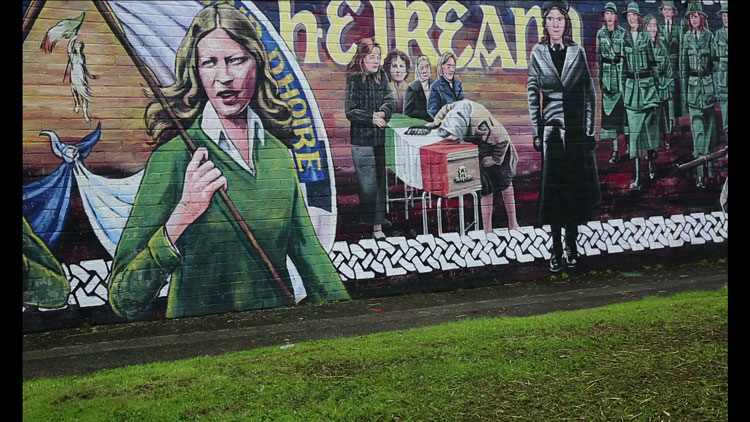
Helen Cammock. The Long Note, 2018. Film still. © the artist.
Cammock was born in Staffordshire in 1970 to an English mother and a Jamaican father. Growing up in 70s Britain, she became acutely aware of racism and sexism, as well as the extreme disparities of wealth and poverty, power and vulnerability. Wanting to make a difference, she spent a decade as a social worker in Brighton before turning her hand to art in 2005. As an artist, she has increasingly sought to give voice to the marginalised and oppressed. Recent years have seen her star rise higher than she ever dared to imagine; in 2018, she was awarded the Max Mara Art Prize for Women and, in 2019, she was a joint winner of the Turner Prize.

Helen Cammock. They Call It Idlewild, 2020. Film, 18 min 35 sec. © the artist.
They Call It Idlewild (2020) is a new film and text installation developed by Cammock following her residency at Wysing Arts Centre in Cambridgeshire. The residency, which took place during the autumn and winter of 2019/20 was commissioned as part of Wysing’s 30th-birthday programme. Inspired by the forgotten histories uncovered in the centre’s archive, the film reflects on the politics of idleness and what it means creatively, emotionally and culturally to be idle at a time when questions are being asked more widely about the physical and emotional cost of hyper-productivity required by modern life.
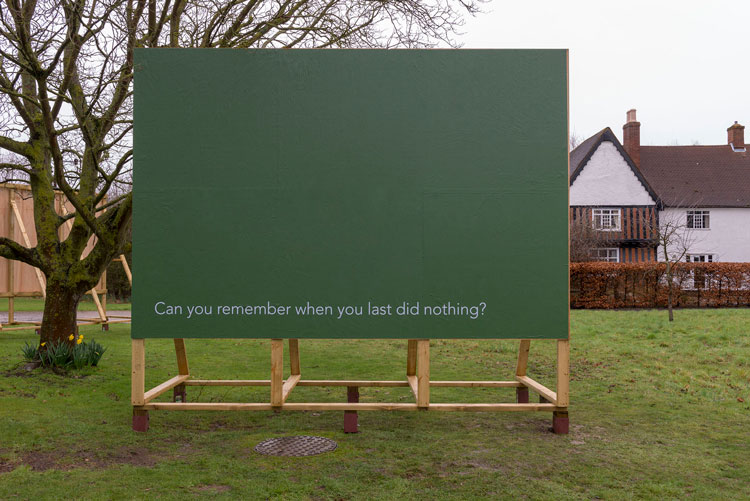
Helen Cammock. Can you remember when you last did nothing? Billboard, installation view, Wysing Arts Centre. Photo: Wilf Speller.
Outside Wysing, two large billboards pose questions to passing commuters: “Can you remember when you last did nothing?” one asks. Until recently, many would have struggled to provide an answer, yet in the age of coronavirus and the recent lockdowns that have accompanied it (and prematurely closed Cammock’s exhibition), the issue of idleness seems more timely than ever. In this interview, conducted before the UK was ordered to self-isolate, Cammock discusses her inspirations for They Call It Idlewild, different understandings of idleness and the role that writing plays in her practice and how her time as a social worker feeds into her art.
David Trigg: Wysing Arts Centre feels quite remote. What was it like living on site during your residency?
Helen Cammock: My residency took place last autumn, during the time of my Turner Prize exhibition. I also had lots of other things going on, so the team at Wysing agreed that a flexible residency, in which I could come and go, would work best. I stayed there for three or four days at a time and also for a few days during the Christmas break.
DT: So, it become something of a getaway?
HC: Yes, and that’s how the new film came about. I was tasked with making a work in response to Wysing’s archive. But when I got there and sat down, it was so quiet that I found myself looking out of the window; it was late summer and the trees were just beginning to turn. I started looking through the boxes, but I soon realised that I didn’t want to make a direct response to the archive, I wanted to respond to Wysing as a site and as an idea. Having said that, the archive is very present in the film.
_Wysing-Arts-Centre_6.jpg)
Helen Cammock. They Call It Idlewild, 2020 (still). Wysing Arts Centre. © the artist.
DT: Yes, it is referenced in the voiceover and the children’s drawings that you found are included in the film.
HC: They were 35mm slides that I found in an envelope labelled “unknown slides”. I went through all of them and selected the ones I was taken with. The voiceover also references a text I found in the archive. I was going through a box filled with prints that had little bulldog clips on them. Obviously, it had been a display at some point and one of the texts arrested me because it was about silence.
DT: How did you make the leap from engaging with the archive to landing on the theme of idleness?
HC: It began with looking out of the window at Wysing and realising that it was the first time I’d sat down and done nothing in many years – life has been crazy for a long time. I started to write about the space I was sitting in, what I could see, what I could feel and what I began to imagine. Then I started looking at the archival material, the cardboard boxes, the window and the fly that kept coming in. I was just writing and writing and writing; it was like a stream of consciousness. I started thinking about idleness, what that means and how it might be linked to Wysing and the politics of labour and making.
DT: They Call It Idlewild is quite different from your recent works, which have focused on uncovering marginalised voices from history. This piece seems more intimate and personal; it is rooted in your experience of a specific place.
HC: Yes. It feels closer to my film Changing Room(2014), which was shot in my dad’s house just after he went into a care home. In that work, I filmed the space, the objects on the shelves, other incidental details and, most importantly, his ceramics. Idlewild is similarly insular and personally reflective. It has been a while since I’ve made a film like this; it is possibly a reaction to the kinds of films that I’ve been making recently, but also to the room I was living and working in at Wysing.
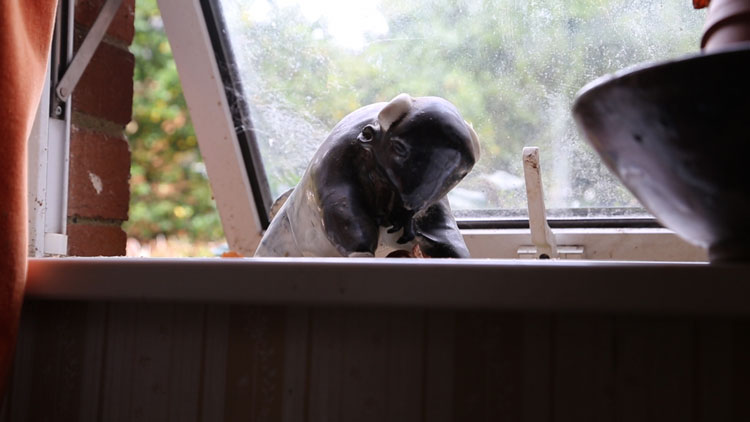
Helen Cammock. Changing Room, 2014. Film still. © the artist.
DT: Idleness is usually considered a negative trait; “the Devil finds work for idle hands” is a phrase that springs to mind. But your film seems to propose that idleness might even be essential to the creative process.
HC: Absolutely. The more I thought about the notion of labour and what it means to create something, the more it made sense to me that creativity requires a space of idleness, of being still. I sit in my bed every morning and stare out of the window for as long as I possibly can before I have to get up. Also, I love driving and that is a space where ideas often develop because I’m trapped inside an insulated environment. Of course, when you’re driving, you’re not doing nothing, but there is something about the idleness of the mind in this vacuum which is interesting to me. It also happens when I’m walking; the other day I went for a walk and, suddenly, before I knew it, I was writing a poem. Of course, I had to stop to write it down and later went back to it to edit, but essentially it was born through the act of walking – without the plan to labour at writing.
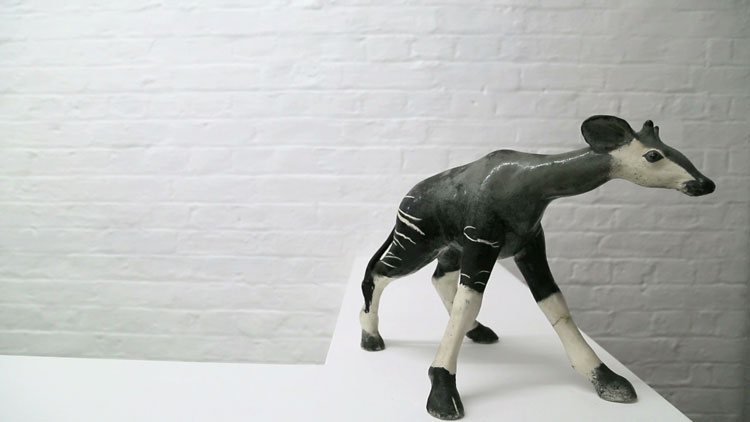
Helen Cammock. Changing Room, 2014. Film still. © the artist.
DT: Writing seems to play a significant role in your practice.
HC: Writing and language are the foundations of everything I do, whether video, prints or even drawing. An idea might spark my interest, but it always gets developed through writing. Perhaps it comes from the fact that I didn’t read as a child; I couldn’t tell the time until I was 12 and I didn’t really engage with reading until around the same age. I was really good at writing, but I just could not take in information easily through reading. Slightly despairing, my mum introduced me to poetry – initially the Liverpool poets. They were short poems that connected with the complex nature of the everyday and human emotion and therefore with my imagination. That was when I began to understand what words could achieve, that it wasn’t about having to read an entire novel. Poetry opened up this space between words that allowed my head to do its own work and without having to concentrate for long periods.
DT: You often draw from a variety of sources: authors, novelists, philosophers and lyricists. The mediation of different voices is an important element in all of your works.
HC: There is a lot of talk about the marginal voice in relation to my work, but also what I’m interested in is the voice more generally – what it means to have a voice, to use your voice and to hear other people’s voices; what the voice is physically, emotionally and also politically. And I’m interested in how new narratives can develop from the weaving together of multiple voices.
DT: What leads you to specific voices?
HC: Sometimes I research people that I’m already interested in, so Audre Lorde and James Baldwin, for example, appear a lot in my work because I am really interested in what they have to say. At other times, it can be a conversation. For example, I wouldn’t have read Jonathan Crary’s book 24/7 if Wysing’s curator, John Bloomfield, hadn’t introduced it in one of our conversations. Those kinds of exchanges are really important to me; talking with people is a way of increasing knowledge, but also about exchanging ideas.
_Wysing-Arts-Centre_2.jpg)
Helen Cammock. They Call It Idlewild, 2020 (still). Wysing Arts Centre. © the artist.
DT: Your voiceover text in They Call It Idlewild takes us to many different places, but the images on screen are all of the Wysing site. What is the relationship between text and image in the film?
HC: Each one sets the stage for the other. It is important for me that what you see on the screen is different from what you hear. With the voiceover, I am interested in different registers of the voice, so there are poetic texts, singing and sections that are more dense prose. The imagery does the opposite: it is very slow and still because I guess I’m trying to create a space for the language to move and intersect with itself and the visual container it inhabits.
_Wysing-Arts-Centre_3.jpg)
Helen Cammock. They Call It Idlewild, 2020 (still). Wysing Arts Centre. © the artist.
DT: You often rest your lens on textures – the brickwork of a wall, say, or the fabric of a cushion.
HC: The idea of touching history is really important to me. My residency was a part of Wysing’s 30th anniversary and I wanted the film to “touch” what has come before, moving across environment and time. This can be about story and voice, but also materials, about fabric, about texture – the haptic quality of the work. I wanted to show the bricks, the stones and the horrible yellow blanket that I sat on. Actually, the more I looked at that blanket I realised it had become a landscape. Similarly, with the closeups of the cobwebs against the orange wall with the black cladding, they too became landscapes. So, there were these micro-landscapes and then the actual landscape, when I pull back to get a full view of part of the Wysing site. I want viewers to experience something of what I felt and touched while I was there.
_Wysing-Arts-Centre_4.jpg)
Helen Cammock. They Call It Idlewild, 2020 (still). Wysing Arts Centre. © the artist.
DT: What led you to Johnny Mercer’s Depression-era song Lazy Bones (1933), which you sing in the film?
HC: My dad used to sing it to us as children if we wouldn’t get up in the morning. When I was thinking about idleness, that song just came into my head. My dad was Jamaican and used to talk to us all the time about how we, as black people, always had to be three times better than everyone else or we would get nowhere. So, there was this message for us, which was very clearly about race. I see it everywhere now – the people who are supposedly the scroungers, the people who are not contributing enough to society, they are still overwhelmingly black and brown people. That’s the message, that’s the narrative.
DT: I’m intrigued by the history of that song. Johnny Mercer was a white American, writing in a style influenced by life in the deep south.
HC: It was interesting to me that it was written by a white man. Mercer really loved jazz and was working with black musicians all the time, so he was embedded in a scene. Perhaps he was genuinely unaware of how that song came to be used and understood. He may well have written it about a white farmhand. Who knows? But it became associated with the trope of the lazy black person – it became part of a metanarrative.
DT: Yes, which has its roots in American slavery.
HC: That’s the irony – that you’re labelled as lazy despite working harder than anyone else for nothing apart from bondage, punishment, pain and degradation.
DT: From racial stereotypes and slavery, your text goes on to take aim at the land-owning classes, business owners and politicians who accuse others of laziness, yet whose wealth is built on the labour of others.
HC: I want people to wake up, to start recognising what’s happening and what’s always happened. Disabled people, old people – anybody who has a marginal position in society – are labelled lazy, accused of doing nothing and contributing nothing. The film attempts to draw distinctions between laziness and idleness, through labour and freedom.
DT: But are we not also implicated? Our western lifestyle is built on the exploitation of others, both historically and today.
HC: Yes, we are absolutely implicated. We sit here wanting everything – mobile phones, clothing, the latest devices – but somebody else has to work, often perilously hard, to produce these things. Of course, you and I don’t consider those workers to be lazy, but those in power do, and we still want what is produced by them. It is my hope that people start thinking about these things, about who is truly lazy in our society. And what it means to be lazy and what it means to be idle.
DT: Music seems to be an important element of your work.
HC: I love music and I love to sing, but it is more the action of music that interests me. Songs are received in a completely different way from the spoken word. Music opens up a different way to receive and understand information and process emotion. I believe very strongly that words do something very different when they become a part of a sound that is sung or played. Also, I express myself in a completely different way when I sing – I go somewhere else in myself and am able to convey and use language in a different way.
DT: You sang semi-professionally as a teenager. Do you ever wish you had pursued that career?
HC: I do sometimes. In my late teens, I thought I would pursue singing and make a living as part of the folk scene. But I got into social work instead and put everything into that and music fell away. Now I feel able to use song in my work to achieve other intersections in the conversations happening.
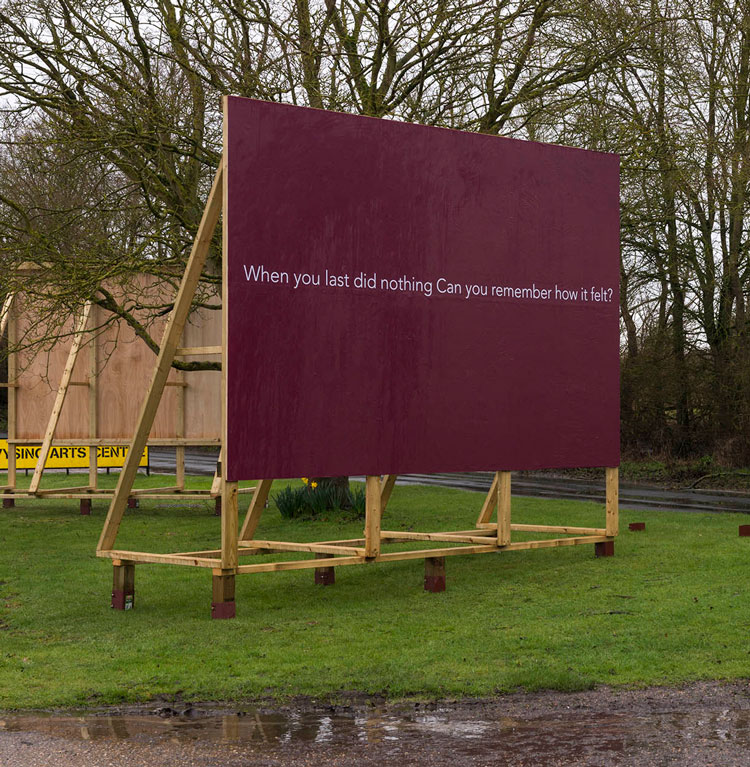
Helen Cammock. When you last did nothing Can you remember how it felt? Billboard, installation view, Wysing Arts Centre. Photo: Wilf Speller.
DT: At Wysing, you have installed two large billboards. They function quite differently from your film, speaking to commuters on the road outside.
HC: I spent a long time watching that road from my window. It’s really quiet in the middle of the day, but very busy at rush hour with lots of huge cars. Most of those drivers probably wouldn’t visit Wysing, or even know what it is, so I wanted to speak to them. I wanted to ask them some questions in the knowledge that I would never know the answers, but that they would have a moment to think about the notion of idleness. Some drivers slow down to look and I saw a couple of cars with teenagers in the back, straining to look at the boards as they passed.
DT: Your use of typography is very distinctive.
HC: I’m very drawn to simple lines. Even though I live my life in a way that can appear hectic and sometimes chaotic, my aesthetic is very much about simple form and line. I always leave a lot of space around the text because I want the images to be like the portrait of language. It allows the language to speak and be heard. Colour is also very important to me; I can take ages to choose colours or mix inks if I’m in a print studio because I have this vision in my mind and it has to be just right.
DT: Your journey into art has been quite unconventional. You worked as a social worker in Brighton for a decade before coming to art in 2005. Your father was an amateur ceramicist and art teacher, but what led you to make that decision?
HC: I had got to a point where I hadn’t sung or performed for a long time, my guitar was sitting there and I had this hole, a feeling that I wanted to do something else, something creative. So, I went to an adult learning class at the University of Brighton. It was called Saturday Art School and was run by practising artists who lectured at the university. We would be set briefs, work on projects and have crits. It gave me a “space for making” where I would spend whole days in a photographic darkroom making prints – an absolute luxury that has never happened again. It made me realise that I needed to do something different, so I decided to go back to university. I thought studying would offer me something I desperately needed while carrying on with my social work practice, but before I knew it I was offered a job running the Brighton Photo Fringe festival and then I got invited to apply to the Royal College. After I graduated, I worked for art charities and arts institutions and chaired a foster panel until my studio practice began to take priority.
DT: How have your experiences as a social worker fed into your art practice?
HC: As a social worker, I was working with people in very challenging situations. You have to learn how to talk to people and ask questions regarding very difficult and sensitive issues. I recognised the importance of genuine humbleness and a sense of humility that I’ve brought with me into my practice, especially my workshops and performances, like the ones I did in Italy and at the Whitechapel with people who were sharing stories of loss and lament; you have to know how to treat people and their contribution with respect. Also, the ability to articulate honestly, to be genuine and respectful and make decisions about what goes into my films and performances is really important to me. Those kinds of ethical decisions come from a place where I had to do that a lot.
DT: Being a social worker is a significant responsibility. As an artist, you now have a prominent public platform. Do you still feel you have a responsibility to make a difference in some way?
HC: There are different pressures, but the responsibility to be myself, to do what it is that I want to do and be true to what I think is right is exactly the same as when I was a social worker. I left social work because the conditions under which I had to work were changing so drastically. I didn’t feel that I could be true to who I wanted to be in relation to the people I was working with. It felt dangerous and I didn’t want to be putting people at risk, particularly young people. I want to be a part of society and have a positive influence; being an artist is one way that I feel I can do that. I thought the same when I was a social worker until I stopped. If one day I end up doing something else, I will take the same approach.
• Helen Cammock: They Call It Idlewild was at Wysing Arts Centre from 2 March to 18 March, closing early due to coronavirus.